Prehistoric rock
carvings and rock art have been found in several places around Qatar. Some of
these drawing depict humans, animals (like turtles, ostriches, and fish), and
boats while others were merely geometric and tribal designs.
There are a ton of
other folk art styles. Weaving and dying fabric is common, especially in a
Bedouin fashion. Typically sheep or camel wool is used while the dyes were made
from herbs and other natural resources. Embroidery was also a common ornamental
feature in clothing. Gold threads imported from India were frequently used.
There were several different kinds of stitches used as well as designs like
flowers and birds.
A certain amount of
art and aesthetics went into their historical architecture as well. Although
simply made, geometric shapes and symmetry were important decorative features
in homes. Elaborately designed doors are frequently created from wood or metal.
Much of their architectural design was created with the heat in mind, and windows
were seldom used. Instead, they used other ways of ventilation. However, there
were vertical windows that were designed to pull in wind and naturally cool the
inside of the building. Colored glass is sometimes used as a decorative
feature.
Although calligraphy
has long been an art form, painting didn’t really gain popularity until after
the oil boom struck. Common themes include Arabic and Islamic culture. In order
to cultivate more artists, the government offered scholarships to young artists
to study abroad, bringing back what they learned to share through exhibitions.
Art museums and galleries were then built to preserve and promote Qatari art.
Jassim Zaini is often considered the founder of the modern art movement; other
artists of note include Faraj Daham, Wafika Sultan Al-Essa, Yousef Ahmad,
Salman Al-Malik, and Hassan Al Mulla.
Historically,
poetry has been an important part of literature and has been practiced for many
centuries. During the 7th century, Qatari ibn al-Fuja’a was well known for his
poetry and often considered a folk hero of sorts. Most poetry during was oral
and performed during social events. The most common type of poem is the Nabati
poem and passed down from generation to generation. Today, they’re still being
read on radio and television. Women were also poets as well, but they mostly
wrote laments called ritha, which served as elegies.
Modern literature,
written in Arabic, didn’t really begin until the 1970s when they gained their
independence from Britain. And this is one art form where females have been
included pretty much equal to men from the beginning. What is amazing is that
the first person to publish a book was a woman: Kaltham Jaber first published
her anthology of short stories in 1978.
Up next: music and
dance





No comments:
Post a Comment